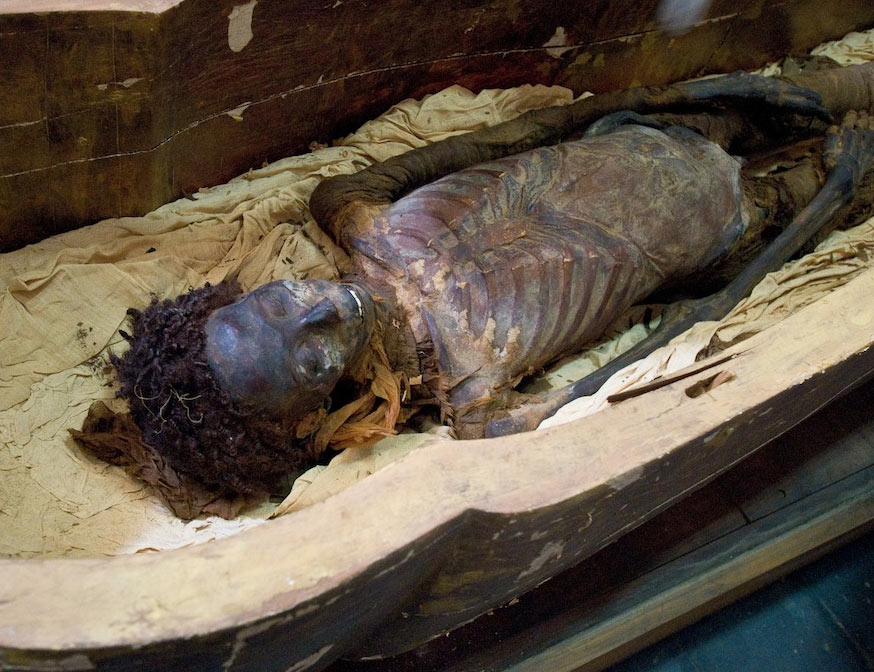NY Mummy Smugglers Reveal Vast Antiquities Black Market

The rescue of an ancient Egyptian mummy's sarcophagus this month from alleged smugglers in New York — the first time authorities say an international artifacts' smuggling ring was dismantled within the United States — sounds more like the plot of a movie than reality.
Amazingly, however, mummy smuggling not only still happens today, it was once so common that enough mummies were available to be ground up and sold as powder, archaeologists reveal.
"Mummy powder was something you could buy in pharmacies up to 1920, because people thought it was a type of medication," said Egyptologist Regine Schulz, curator of ancient art at the Walters Art Museum in Baltimore.
Today's black market for mummy and other antiquities is in the billions of dollars, though exact numbers aren't known. Besides not having a clear bead on the breadth of trafficking in Egyptian artifacts, scientists and officials say it's often difficult to protect the precious artifacts as the Egyptian desert is so vast. [Science as Art: A Gallery]
A long history of mummy dealings
The trafficking of mummies traces back to medieval times.
"When Christianity and Islam were rising, mummification was not really the main habit anymore, although we have some mummies of Christian bishops in Egypt that do date back to the seventh and eighth centuries A.D.," Schulz said. "So from the Middle Ages on, mummies were a bit curious and strange."
Get the world’s most fascinating discoveries delivered straight to your inbox.
Nevertheless, so many mummies were made during ancient Egypt times that enough were available to make mummy powder, or mummia, whose pigment "one assumes was a dark brown," said Gary Vikan, director of the Walters Art Museum.
"Mummification was not just something for pharaohs or the upper class — it was the normal thing in ancient Egypt for hundreds of years," Schulz said. "My aunt lived for many years in Egypt in the 1950s and 1960s, and sandstorms would often reveal tiny remains of mummies — sometimes a little wrapping, sometimes a little bone." [Top 10 Weird Ways We Deal With the Dead]
Given the way mummification helped preserve the body, people thought mummies had something to do with eternity, and, in turn that mummy powder could be used as medication, Schulz said.
As strange as grinding up ancient corpses for sale might be in modern times, "mummies were seen as objects back then, not people," Schulz said. "There was nothing illegal about it."
Nowadays, smuggling mummies and any other antiquities out of Egypt is strictly against the law.
"People began to say, 'Wait a moment, this is a person that should be treated in a respectful way, not a thing,'" Schulz said.
Still, while traffic in mummies and Egyptian antiquities has fallen, a black market for them still exists, and the recent upheaval in Egypt may have made it easier for criminals to loot the country.
Modern crime
In the latest news in this front, on July 13 federal prosecutors announced they had busted an international antiquities smuggling ring, charging antiquities dealers in New York, Michigan and Dubai with conspiring with a collector in Virginia to smuggle Egyptian artifacts into the United States and launder money to further their crimes. The prizes in question include a Greco-Roman style Egyptian sarcophagus, a nesting set of three Egyptian sarcophagi, a set of Egyptian funerary boats and Egyptian limestone figures, a collection with an estimated market value of $2.5 million.
"This is a groundbreaking case for Homeland Security Investigations — it is the first time an alleged cultural property network has been dismantled within the United States," said James Hayes, special agent-in-charge with U.S. Immigration and Customs Enforcement and Homeland Security Investigations. "In addition to smuggling cultural property, this case also focuses on significant money-laundering activity. This is notable because the illicit sale of cultural property is the third most profitable black market industry following narcotics and weapons trafficking."
The specific numbers regarding art crime remain vague at best, due to the dearth of accurate statistics regarding it, but estimates have suggested it brings in $2 billion to $6 billion annually.
There is no doubt an illegal market for mummies — "people are still interested in buying them," Schulz said. "But people are more interested in their coffins or maybe a nest of coffins, in what is around the mummy. The mummy itself is not the highest priority."
A great deal remains unknown as to how much gets smuggled or what even gets stolen. The International Council of Museums is preparing a red list for Egypt — a catalog of archaeological objects and works of art in danger of getting stolen or sold. Still, in places in Egypt where families are poor and foreigners are offering a great deal of money, "it's not surprising if there are people who excavate and sell things even if it is illegal," Schulz said.
At the same time, the vast nature of the desert in Egypt makes it impossible to defend every possible site from looters.
There remains much scientists can learn about the past using mummies, even without unwrapping them. "We can now X-ray them to find out how old they were, what illnesses they had, what they ate and what might be inside the wrappings. We can learn a lot about the ancient Egyptians and also the individuals. If you are illegally dealing in mummies and looting tombs, you're destroying what we can learn."
Follow LiveScience for the latest in science news and discoveries on Twitter @livescience and on Facebook.



